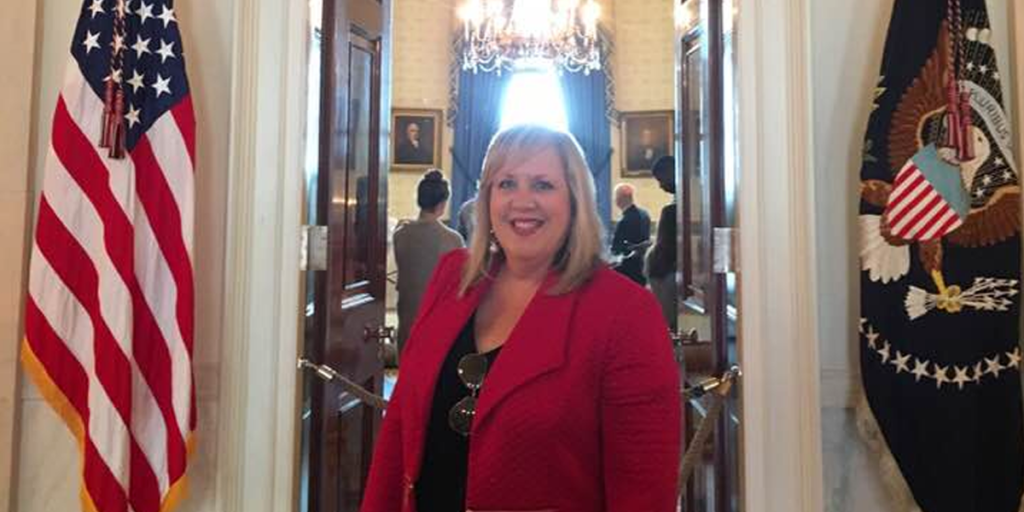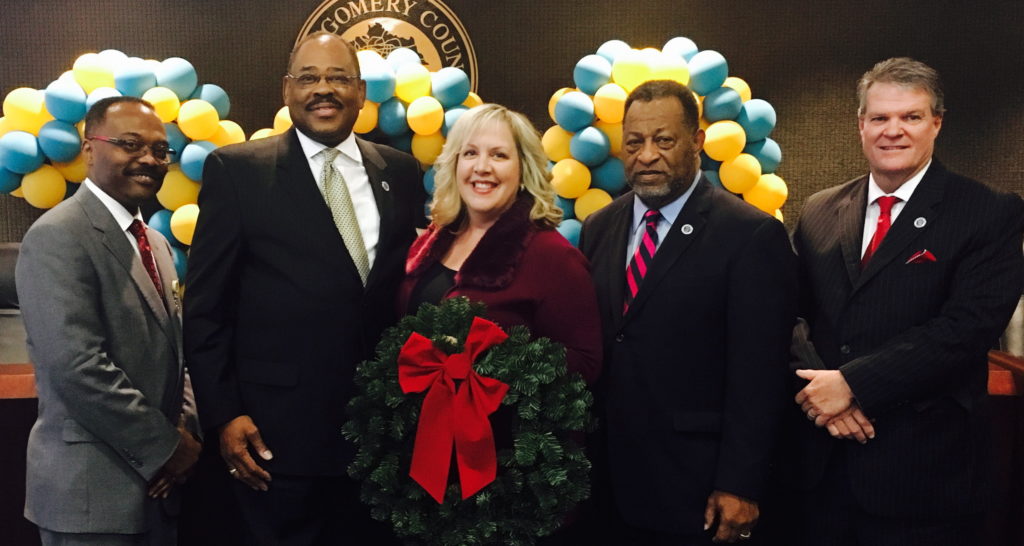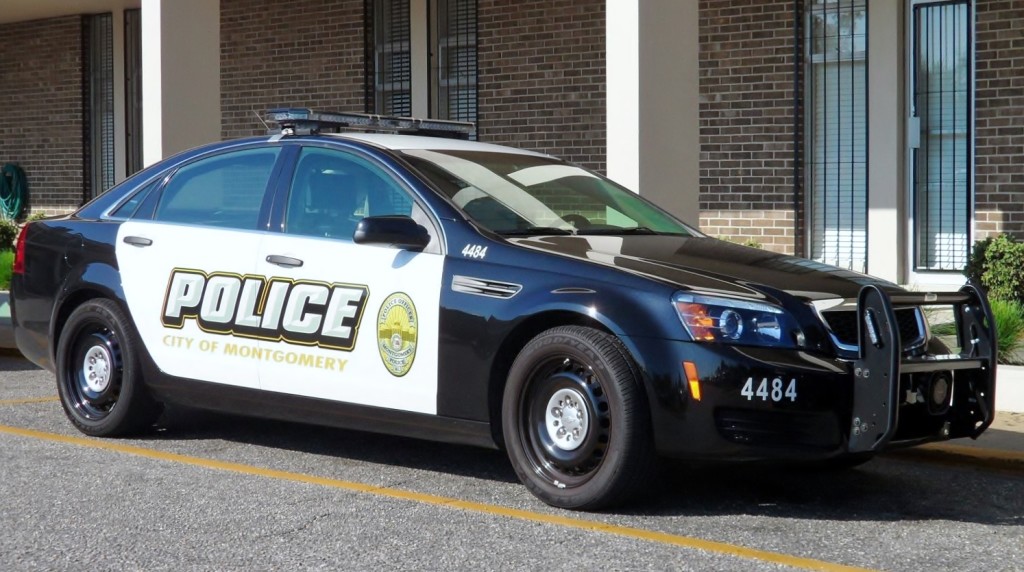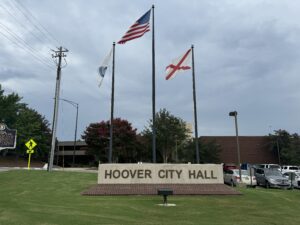Understanding Montgomery County local amendment 1: retirement for County Commissioners

When Alabamians get to the polls on Tuesday, Nov. 6, voters in some counties will see local amendments on the ballot. Here’s a look at what residents of Montgomery County need to know about a local amendment they’ll see on the ballot: On the ballot: PROPOSED LOCAL AMENDMENT NUMBER ONE (1) Relating to Montgomery County, proposing an amendment to the Constitution of Alabama of 1901, to allow the members of the Montgomery County Commission to participate in the Employees’ Retirement System. (Proposed by Act 2018-388) Vote: Yes/No What it means: If passed, the amendment would allow the members of the Montgomery County Commission to participate in the Employees’ Retirement System that is part of the Retirement Systems of Alabama (RSA). Employees must serve at least 10 years to be vested for the benefit. Sample ballot Click out the Montgomery County sample ballot: Front side | Back side Don’t live in Montgomery County? Find your county’s sample ballot here.
Ronda Walker represents Montgomery County at White House meeting

Vice Chairman of the Montgomery County Commission Ronda Walker is in Washington, D.C. representing the county as part of the Alabama and Louisiana White House Conference. “It’s critical that we on the local level engage with our state government as well as the federal government to discuss issues that are important to Alabamians,” Walker told WSFA-12. There, the group will discuss topics such as energy, agriculture, infrastructure and education and how the White House can help meet the two state’s needs. “We want to take advantage of this opportunity,” Walker added to WSFA. “They need to know all the good that is happening here in Alabama and also be made aware of the needs we have. We are very close to the people we represent and it’s important we convey what matters.” Walker took to Facebook on Thursday to share her excitement over the trip. “Proud to represent Montgomery County at the Alabama Leadership meeting at the White House today,” she posted. She was also interviewed outside the White House about her meetings.
Jefferson, Mobile and Montgomery among 2 percent of counties that make up 51 percent of U.S murders

According to data from the Crime Prevention Research Center, 2 percent of counties in the nation make up 52 percent of murders throughout the nation. Alabama has three counties that make up part of that two percent; Jefferson, Mobile, and Montgomery. The state also had the third highest murder rate in the nation in 2016 with 407 murders out of a 4.8 million people population, giving the sate an 8.4 murder rate. According to the Alabama Law Enforcement Agency’s crime in Alabama report: In 2016 Jefferson county endured a total of 104 homicides, 78 of those taking place within the Birmingham city limits. The homicide rate was 15.69 per 100,000 people, and to put that in perspective, the national homicide rate was 5.3 per 100,000 people in 2016. Mobile county experienced a total of 61 homicides in 2016, 44 took place within Mobile city limits, and the homicide rate was 14.71 per 100,000 people. Montgomery county had the lowest number of the three, with only 31 total homicides, 30 taking place within Montgomery city limits. The county’s homicide rate was 13.76 per 100,000 people. According to the Crime Prevention Research Center: In 2014, the most recent year that a county level breakdown is available, 54 percent of counties (with 11 percent of the population) have no murders. 69 percent of counties have no more than one murder, and about 20 percent of the population. These counties account for only 4 percent of all murders in the country. The worst 1 percent of counties have 19 percent of the population and 37 percent of the murders. The worst 5 percent of counties contain 45 percent of the population and account for 68 percent of murders. As shown in figure 2, over half of murders occurred in only 2 percent of counties.” Murders actually used to be even more concentrated. From 1977 to 2000, on average 73 percent of counties in any give year had zero murders. Location is not the only factor in the concentration of murders; according to a 2013 PEW Research Center survey, gun ownership rates in rural areas were 2.11 times higher than in urban areas. In short, suburban households are 28.6 percent more likely to own guns than urban households. Most of the country has both very high gun ownership rates and zero murders. According to the data, murder isn’t a nationwide problem; and few people appreciate the large areas of the country where there are no murders. Researchers say that the problem lies within a very small set of urban areas, and the gun ownership, or lack of legal gun ownership, within those areas. To solve the problem, the Crime Prevention Research Center suggests focusing on the areas where murders are most common and doing what is necessary to reduce the amount of murders in that area. Here is the map detailing the counties in U.S. with highest murder rates:
State board votes to intervene in Montgomery County schools

The state school board voted unanimously Thursday to intervene in the Montgomery County school system because of concerns about academic and financial performance. Superintendent Michael Sentance said in a press conference after the vote that too many of the system’s schools were “at a low level and staying at a low level.” “It’s my personal belief that a capital city school system should be a shining example of what public education should be in the state. It should be a model,” Sentance said. State law allows the Alabama Department of Education to take over school systems because of problems with academics or fiscal management. Sentance said Thursday said there were concerns with both aspects of the Montgomery system. The state has intervened in several school systems in the past, including Selma and Birmingham. What state intervention might look like depends on the school system and reason for the intervention. In Selma, the state placed the school superintendent on leave and assigned someone to assume his duties. Sentance, said he didn’t know what all would happen in Montgomery, but said he envisions a collaborative process. One issue he said they will address is making sure classroom teachers have adequate knowledge in their subjects. “We have to raise the understanding of content with a lot of teachers in schools, starting with elementary on up. We would be coming in with some ideas how to do that,” Sentance said. Intervention does not automatically bring more money. The state could help the system with grants and will provide additional personnel. Montgomery County is a large school system that included a mixture of high-performing magnet schools — which skim off the best students and boast some of the highest test scores in the country — and high-poverty schools with low test scores. Sentance said the state will only get involved in schools that are struggling. The system had 10 schools labeled as “failing” for being in the bottom 6 percent of standardized test scores. Sentance said many more are chronically struggling, enough to trigger the state intervention option. The state board vote is the first step in the intervention process and sends a notice to the local system about the board’s intent to intervene. The local system has 21 days to respond to the intervention notice and could propose its own plan to address the problem. The state board will vote in February on whether to proceed. Some Montgomery school officials said Thursday that they welcome the move. Montgomery County Board of Education President Robert Porterfield said the state can bring needed resources to help do what is “best for children.” “There is a great heart here to improve schools,” Sentance said. State Board member Ella Bell, who represents much of Montgomery, said she thought the county schools had been suffered from “historic neglect” and a chronic underfunding because of the county’s low tax support for schools. “This is the first time the state has ever, ever reached out to bring children of color, our poor white children, up to a level of prominence with all the other school children in this state,” she said. Republished with permission of The Associated Press.
Ronda Walker: Happy Birthday Montgomery County

U.S. Army officer Lemuel P. Montgomery founded Montgomery County, Alabama in 1816 in what was then the Mississippi Territory. Montgomery County is older than the state of Alabama and has seen many changes over the past 200 years. The Montgomery County Commission spent all of 2016 celebrating the county’s bicentennial. The Commission has recognized the individuals that served and sacrificed to explore, develop and grow our county over the past two centuries. Among the activities done to honor the county this year: our school children made giant birthday cards and presented them to the Commission, local students designed and built a lovely metal statue, there was a celebration at our local fair, and county employees walked two hundred miles during the spring, and ESPN invited the Commissioners onto the field for recognition during the Camellia Bowl. As current residents of this beautiful land, it is our privilege and responsibility to build on what we have been given and to lay the foundation for the growth that will occur over the next 200 years. I was raised in Montgomery in the 1970s and 1980s and spent my youth playing softball, going on church trips, cheerleading for my public school, and participating in YMCA programs like Youth Legislature. My middle class family was loving and supportive and I was blessed with a simple but idyllic childhood. Since then I’ve lived in several U.S. states and in the metropolitan areas of Washington, D.C. and Honolulu, Hawaii and enjoyed my time in each place. But I’m glad I’ve come full circle and am raising my children in Montgomery. I desire for them to have all of the things I did… and much more. Montgomery has a small town feel with some wonderful big city amenities. If my husband and I want to dine at a nice restaurant we have multiple options. We can enjoy live theater at the nationally acclaimed Alabama Shakespeare Festival. The symphony and ballet offer spectacular entertainment. Or we can enjoy local theater at the Cloverdale Playhouse. Experiencing a night with the Montgomery Biscuits – our Double A baseball team – is a favorite pastime of thousands locally. The Shoppes at Eastchase offer anything your retail heart desires. For my children there is little league, the zoo, movie theaters, and museums. Our economic engines like Hyundai Motor Manufacturing Alabama, Coca-Cola United, and the many farms that dot the rural landscape blend nicely with our perennial powerhouses like Maxwell-Gunter Air Force Base, state government agencies, and the many colleges and universities in our area. But I believe Montgomery’s best resource is her people. Smart, genuine, hard-working individuals who have a deep faith and desire to serve. When your family welcomes a new baby, or you have an unexpected surgery, or when you experience a personal loss you can know someone will be on your front porch with a casserole within the day. Going out of town? Just ask a neighbor to check your mail and keep an eye on your home. Neighborhood associations throughout the county are strong and create small communities that watch out for each other. Walk downtown and you’ll get plenty of “hey y’alls” and doors held open. It’s a friendly, easy place to live. But it would be disingenuous of me not to mention that the people of Montgomery have unique challenges, many related to our past. When we insisted on separating black people and white people in public spaces and we justified denying an entire race of citizens their rights, we set the stage for future divisiveness and strife. When white Montgomerians nailed signs onto the walls of shops indicating what your skin color had to be to drink from a certain water fountain we set ourselves up for brokenness. Although my hands never held a hammer or drove a nail, my white-skinned family pays the price for the sins of our forefathers. Older black residents remember well the days of hatred, lost opportunity, and at times despicable brutality. For some, that brokenness manifests itself now in anger and distrust. However, many blacks of the 1960s generation see a new hope and vision for Montgomery. Although borne of a divide, we are a new Montgomery, a stronger Montgomery. Montgomery County is now majority black and our leadership has transitioned from predominantly white male to a strong blend of black, white, male, female, young and old. While some see the shifting demographics as a negative most, like myself, see it as a tremendous opportunity. As a new generation of Montgomery comes of age and rises to new leadership roles, we have an opportunity to show the nation how we can live together and succeed together as brothers and sisters so that we do not perish as fools. We will build the strongest community not just in the South, but the entire nation and we will do it as a blended microcosm of all that is great in our country, not as a segregated enclave reflecting an aged and unnecessary monolith. We will show our neighbors how people from different backgrounds, different generations, different races, genders, and social circles can come together and infuse our community with the best that every individual has to offer. Education, economic growth and crime are the issues of greatest concern for individuals across our nation and Montgomery is no different. Montgomerians will not bow to the negative rhetoric and disdain from those who prefer to sit comfortably shouting about problems rather than digging deep for solutions. We will focus on individuals and building relationships and from those relationships we will problem solve together. We will rise above our past and create a future many cannot imagine. Yes we have our mountains to climb, but if we will lay aside our individual agendas and consider the needs of future generations we will succeed. We cannot get stuck dwelling on our problems, rather we must work on solutions to critical issues such as expanding broadband access in the county and marketing our new Montgomery
Bill banning speed cameras in police cars passes House committee

The House Committee on Montgomery County Legislation approved a bill Tuesday that would prohibit Montgomery police from using traffic cameras in unoccupied cars, a practice approved by the Alabama Legislature in 2011. SB201, sponsored by Sens. Dick Brewbaker (R-Montgomery) and Quinton Ross (D-Montgomery), comes out of public resentment for the police practice, which essentially establishes decoy cars throughout the city and issues tickets via mail. The 2011 bill specifies that the tickets should be mailed to residents within 30 days of the offense and include a picture of the offending vehicle and license plate, a description of the offense and the time, date and location of the violation. An amendment to the legislation was offered, which would have allowed the cars to be used in residential and school areas but prohibit them on four-lane roads, federal and state highways and in construction zones, but the committee tabled it. In a statement on Facebook, Montgomery Mayor Todd Strange said he was “disappointed” with the committee’s decision, saying that the cameras in residential and school areas are “a tremendous force multiplier that supplement manned enforcement by our traffic officers while allowing other police personnel to fight crime, protect and serve,” explaining “our neighborhoods, our schools and our children” would stand to lose the most. “We will continue to oppose this bill when it reaches the floor of the Alabama House and again ask the members of the Montgomery delegation to seek the opinion of the neighborhood associations and schools regarding the effectiveness of the speed car cameras in unmanned marked police cars,” Strange continued. “Speed cameras work.” The cameras generated just over $136,000 in annual revenue in 2015 — less than 6/10 of 1 percent of the city’s general fund — for a department whose budget is slated to surpass $230 million this year. The legislation, which simply states that the 2011 bill be completely repealed, has already passed the Senate and is now cleared to go before the House of Representatives.
Disaster assistance approved for 4 flood-ravaged counties

The Alabama counties of Coffee, Jefferson, Montgomery, and Morgan have been approved for Small Business Administration (SBA) loan assistance, after days of tornadoes and floods severely damaged property and commercial infrastructure there. Three people reportedly died as intense storms flooded much of the state last month when about 14.2 inches of rain fell in some areas. They included one Coffee County man who drowned amid the deluge. Gov. Robert Bentley‘s office announced the federal assistance over the weekend. “Cleanup continues in many communities, and assistance from the SBA will go a long way in helping our communities recover from the tornadoes and flooding experienced in December,” said Bentley, who is usually averse to intervention from Washington. “There is help available for homeowners, businesses and nonprofit organizations that suffered damage from the storms. From the time the storms and flooding hit our state, to seeking today’s disaster declaration from the SBA, we have been working with affected communities and connecting them with resources available,” Bentley said. Aside from the four primary disaster areas listed above, the following counties contiguous with those counties are also eligible for some help: Autauga, Bibb, Blount, Bullock, Covington, Crenshaw, Cullman, Dale, Elmore, Geneva, Lawrence, Limestone, Lowndes, Macon, Madison, Marshall, Pike, Shelby, St. Clair, Tuscaloosa, and Walker. According to the governor, the assistance comes in the following forms: Home Disaster Loans: Renters and homeowners alike may borrow up to $40,000 to repair or replace clothing, furniture, cars, appliances, etc., damaged or destroyed in the storms. Homeowners may apply for up to $200,000 to repair or replace their primary residence to its pre-disaster condition. Business Physical Disaster Loans: Loans of up to $2 million to repair or replace disaster-damaged property owned by the business, including real estate, inventories, supplies, machinery and equipment. Businesses of any size are eligible. Private, nonprofit organizations such as charities, churches, private universities, etc., are also eligible. Economic Injury Disaster Loans: If a small business or private, nonprofit organization has suffered economic injury, regardless of physical damage, and is located in an SBA-declared disaster area, they may be eligible for financial assistance of up to $2 million from the U.S. Small Business Administration. “We appreciate the Small Business Administration for working quickly to approve Governor Bentley’s request,” Alabama EMA Director Art Faulkner said. “AEMA will continue to work with citizens and local elected officials to identify resources that may be available.”


